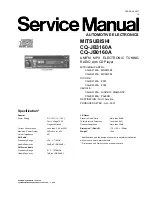
PAGE 4
SAFETY INFORMATION AND WARNINGS
INFORMATION ON SAFE OPERATION
Please read this information before installing or using your UHF radio.
The operation of your UHF radio in Australia is subject to conditions in the following Licence:
In Australia the ACMA Radio communications (Citizen Band Radio Stations) and in New Zealand by
MED the General User Radio Licence for Citizen Band Radio.
SAFETY AND GENERAL USE WHILST IN A VEHICLE
Check the State and Federal laws and regulations regarding the use of two way radios in the area
where you drive, and always obey them.
FOR VEHICLES FITTED WITH AIRBAGS
When using the radio in a vehicle, do not place your radio in the area over an airbag, or in the
airbag deployment area. Airbags inflate with great force, if a radio is placed in the airbag
deployment area and the air bag inflates, it may be propelled with great force and cause serious
injury to the occupants of the vehicle.
POTENTIALLY EXPLOSIVE ATMOSPHERES
Turn your radio OFF when in any area with a potentially explosive atmosphere. Sparks in such areas
could cause an explosion or fire resulting in injury or even death.
NOTE:
Areas with potentially
explosive atmospheres are often, but not always clearly marked. They include fueling areas such
as below deck on boats; fuel or chemical transfer or storage facilities; areas where the air contains
chemicals or particles, such as grain, dust, or metal powders; and any other area where you would
normally be advised to turn of your vehicle engine.
BLASTING CAPS AND AREAS
To avoid possible interference with blasting operations; turn your radio OFF near electrical blasting
caps, or in a “blasting area”, or in areas posted: “Turn off the two way radio.” Obey all signs and
instructions.
EXPOSURE TO RADIO FREQUENCY ENERGY
Your two-way radio complies with Australian Communications Authority Radio Communications
(Electromagnetic Radiation-Human Exposure) Standard, 2003. To assure optimal radio performance
and make sure human exposure to radio frequency electromagnetic energy is within the guidelines
set out in the above standards always adhere to the following radio operating procedures.
RADIO OPERATION AND EME EXPOSURE
Unauthorised antennas, modifications, or attachments could damage the radio and violate
compliance. DO NOT hold the antenna when the radio is “IN USE.” Holding the antenna reduces
the effective range. DO NOT use the radio if the antenna is damaged. If a damaged antenna makes
contact with a persons skin, a minor burn may result.
Summary of Contents for RR50A
Page 1: ...RIDGEACCESSORIES PAGE 1 PRO HANDHELD 52 PLU 564552 ...
Page 24: ...PAGE 24 UHF CHANNELS AND FREQUENCIES UHF CHANNEL FREQUENCY TABLE ...
Page 25: ...PAGE 25 UHF CHANNELS AND FREQUENCIES continued CTCSS TONE TABLE ...
Page 26: ...PAGE 26 UHF CHANNELS AND FREQUENCIES continued DCS CODE TABLE ...
Page 27: ...PAGE 27 UHF CHANNELS AND FREQUENCIES continued DCS CODE TABLE continued ...





































